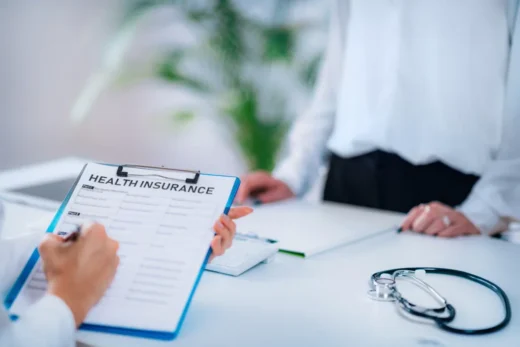Written by Michael LaPick
Healthcare Writer
Reviewed by Garrett Ball
Expert Reviewer
We want to help you make educated healthcare decisions. While this post may have links to lead generation forms, this won’t influence our writing. We adhere to strict editorial standards to provide the most accurate and unbiased information.
There are some very real dangers that come with being underinsured, both to your health and your finances. We offer seven possible options to look into if you find yourself underinsured.
Going without health insurance is a recipe for trouble. Whether it’s skipping preventive care, forgoing important prescriptions, or suddenly being hit with massive healthcare costs, being underinsured comes with a litany of risks. What you may not know is that even having an insurance plan sometimes isn’t enough. Millions of Americans are underinsured, and they face many of the same health and financial risks as those with no healthcare coverage at all. If you’re underinsured, here are some free and discounted healthcare options to supplement your coverage.
The Underinsured Crisis
Though specific definitions vary, a person is generally considered “underinsured” if their out-of-pocket medical costs equal 10 percent or more of their annual household income, or if their health insurance deductible equals 5 percent or more of their income. In effect, an underinsured person has insurance that’s inadequate or too expensive to effectively cover many of their medical costs.
Though the number of uninsured people has dropped significantly in recent years, the problem of the underinsured has only grown. Around 28 percent of all adults with health insurance in the United States are considered underinsured. According to a 2018 survey by The Commonwealth Fund, that’s more than 41 million people. About 30 percent of these underinsured adults reported they had problems paying or were unable to pay a medical bill, and 25 percent had skipped filling a prescription.
The Consequences of Underinsurance
There are many consequences and risks associated with being underinsured.
1.) Many underinsured people avoid routine checkups, vaccines and other medical services that have been shown to reduce health risks and improve overall quality of life.
2.) Some underinsured people take cost-cutting measures like seeking healthcare in less-regulated countries or purchasing prescription drugs online. Or they may cut corners by using less than the prescribed amount of medication or physical therapy.
3.) Underinsured people also frequently delay or refuse medical care in the event of an accident or illness, let alone costly prescriptions.
4.) At-risk children and people who have special healthcare needs suffer greatly from being underinsured and often require services simply too costly even with basic insurance.
The Financial Risks of Being Underinsured
Being underinsured also poses a financial risk. Faced with needing health services, those who are underinsured often find themselves trapped with overwhelming medical debt.
1.) High deductibles or out-of-pocket costs often mean huge medical debts accumulate quickly in the event of an illness or accident.
2.) Life savings are often left depleted.
3.) About a third of underinsured people ultimately turn to credit cards to help cover the costs. Because of high interest rates and other fees, this frequently leads to even greater debt that can run into the tens of thousands of dollars.
4.) In about 7 percent of cases, inadequate insurance eventually leads to bankruptcy. In fact, medical bills are the largest cause of personal bankruptcy. Even for those who manage to avoid catastrophe, damaged credit scores and impaired borrowing ability are common.
Access to Free/Discounted Healthcare
If your health insurance doesn’t do enough to cover your medical costs, don’t avoid that trip to the doctor. Instead, check out the following tips for gaining access to free or discounted health care.
1. Find a Community Clinic
Community clinics may have a reputation for substandard care, but the reality is that most clinics offer a level of care comparable to private clinics for a fraction of the cost. Community clinics typically work on a sliding scale, meaning that you’ll be charged for any services based on your income level and ability to pay. In some cases, you may not be charged anything at all. Training clinics are another affordable option, particularly for services like mental health and dental care.
2. Visit Planned Parenthood
Regardless of your insurance status, Planned Parenthood is often a great way to find quality care at an affordable price. Planned Parenthood offers a range of services, from routine medical care and checkups to mental and reproductive healthcare, and their clinics typically operate on a sliding scale similar to community clinics. Financial assistance may also be available for certain services, and costs for healthcare are generally lower than at hospitals and private practices.
3. Explore Government Resources
If inadequate insurance and sky-high out-of-pocket costs have made healthcare a challenge for you, these government resources may be of help:
- Medicare Savings Programs (MSPs) are available to assist those with Medicare in covering their copayments, prescription drugs and other medical costs.
- The Hill-Burton program, established in 1946, also provides free or low-cost access to various medical services at designated healthcare facilities throughout the United States.
- State Pharmaceutical Assistance Programs (SPAPs) and other programs are also available in many states to defray prescription costs.
These are just a few of the many government-backed resources aimed at assisting uninsured and underinsured people. To find the programs best suited to your needs, contact your local Office of Public Assistance or Social Services.
4. Have Your Debts Forgiven
Being underinsured can lead to massive debts in the blink of an eye, with total debts often running into the tens of thousands of dollars. About 44 percent of underinsured people ultimately experience damage to their credit scores as a result of this debt, and many others face depleted savings and serious lifestyle changes.
One potential lifeline is medical debt forgiveness. Depending on your circumstances, hospitals may be willing to forgive part – or even all – of the amount you owe. There are no guarantees, but if you find yourself in dire financial straits, it’s worth contacting your hospital’s billing department to inquire about the possibility of forgiving or reducing your debts. One thing to note is that cash payers can often negotiate up to a 50% discount when working out a payment plan.
If you do negotiate a reduction, be sure to get the terms and amounts in writing to prevent problems down the road.
5. Opt for a Cash-Only Medical Provider
As the name suggests, cash-only medical providers accept only cash payments. Often referred to as concierge medicine or direct primary care, these facilities cut out the bureaucracy of the health insurance claims process and instead deal directly with their patients. Because they typically require less staff and administrative overhead, these facilities are often able to pass those savings on to their patients in the form of lower prices and more flexible payment options. Many such clinics offer the option to pay in installments, and some also use sliding payment scales to deliver care that’s affordable regardless of income level.
6. Take Advantage of Health Screenings
In addition to the threat of huge debt, bankruptcy and plummeting credit scores, being underinsured also invites the risk of having health conditions undiagnosed because regular checkups are skipped. One option for combatting this risk is to take advantage of free health screenings offered by hospitals and clinics for common health conditions ranging from high cholesterol to diabetes and various types of cancer. Keep in mind that these events may or may not be advertised in the community, so it’s best to call local medical facilities from time to time to inquire about upcoming screenings.
7. Look into medication discount programs
Discount programs for medication are gaining in popularity and importance because of the escalating cost of medications and the inadequate coverage for medications in most health plans. Some examples are GoodRx.com, WellRx.com and Needymeds.org. Visit their websites to see if they may benefit you. If you’re one of the roughly 25 percent of adults whose health insurance simply isn’t adequate to cover your medical costs, finding and paying for care can be difficult and frustrating. Don’t give up hope or delay getting the care you need. Follow the tips above and you can find help with a wide range of medical services, all with little to no additional cost to you.
Thank you for your feedback!


 by
Garrett Ball |
Updated on
August 18, 2025
by
Garrett Ball |
Updated on
August 18, 2025 




